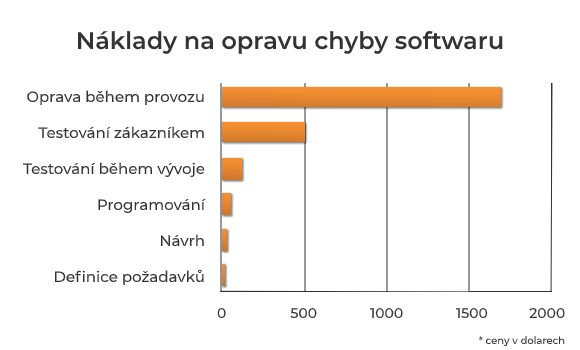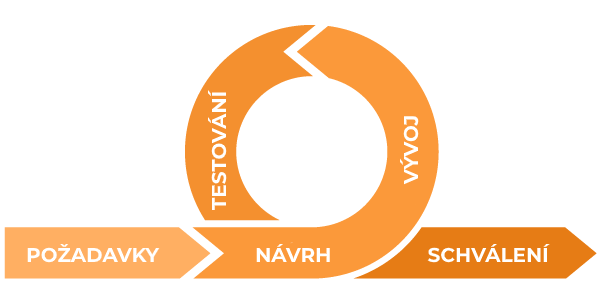Have you found out that some of your processes could be automated or that you need to work better with data in your company? Then you probably know you will need some software, and you may already be writing your plan. These four points will help you get the best possible outcome.
1.Good preparation will save you a lot of money
At the very beginning, it is important to define your software requierements so that it is truly bespoke. You may not want to put the effort into working on a project that hasn’t even started yet. But why not be one step ahead from the start? Especially when consistent preparation can also save you a lot of money. The following chart, based on studies by American software engineer Barry W. Boehm, shows how much consistency in preparation will affect the final software development budget. In the end, you might even have enough left over for a company party.

So how do you figure out what you want from an application? There are a variety of business sectors, so there is no “right ” approach for all. In practice, however, it’s usually unproven across industries to be concerned with details such as the look and feel of an application from the start. As Steve Jobs said, “Design is not just about how things look and feel. Design is about how they work.” Try thinking about the basic questions first, which may seem obvious to you.
- What will be the purpose of your app?
- What tasks should the app perform?
- Who will use the app? A representative of the future users of the application should, if possible, be involved in the development.
- What data will the app work with?
- Will the app need to work with third party systems?
- What will be the user roles and permissions in the application?
- What will be the system and performance requierements of the app? For example, how many users will be able to use it at one time without noticeable performance limitations?
- What is the required completon date and, of course, what is the budget?
These questions will help you get the comprehensive idea of what your software should look like. At the same time, by answering these questions, you will be able to define the brief for the developer more easily. After all, the developers who will be working on your application probably know nothing about your business. In this case, neglecting the brief is the same as sending your colleague to get lunch, he asks what you fancy and because you don’t have time you reply “whatever, something good”. He might actually hit your taste buds, but it is possible he will bring you steamed broccoli. If you prepare well, you can look forward to a much better result.
TIP: If you are not sure how to answer some of the questions, tht’s okay. Set up a no-obligation meeting to introduce your business, and we’ll guide you so that the software effectively addresses your business needs.
2. Prototyping helps you to detect defects early
Let’s say you are already happy with the proposed solution and have signed the contract. What happens next? Waiting for a grandiose unveiling of the finished software that experienced programmers have worked long and hard on “behind closed doors” is a tempting idea, but sadly outdated. Continuous prototyping is much more profitable.
If your developers deliver continuous prototypes, you control costs. As seen in Barry W. Boehm’s chart, the earlier you uncover potential flaws, the more successful and cost-effective the project will be. The worst case scenario is to fix the final product on the fly. If you have not seen the software once from commission to completion, the cost of repair will be much higher than at the beginning. What does this imply? You don’t have to go fishing with the developers, but if you communicate the development continuously, there will be satisfaction on both sides.
In practice, it has worked well for us to prepare the first prototype at the very beginning of development. This is a rough prototype that does not contain the functional core of the application, but you can see a preview of the user experience. By looking at the functional prototype, you can narrow down your ideas and make sure your requirements are correct. And possibly rethink them.
3. Agile development with continuous testing speeds up development
Once the cards are dealt, it is time to develop and test. Development happens in iterative circles. As programmers develop software, they simultaneously test and fix bugs, which, in addition to better controlling costs, also speeds up software development and allows software requirements to be continuously added to based on prototypes that developers deliver.

Once you submit your new requirements to the developers, they process them, test the prototype, and resend it to you to to test and suggest further modifications. This cycle continues until the final software is approved. This is known as agile software development, which is the current development standard. The impetus for this change in developer approach was given by the Agile Software Development Manifesto back in 2001. It is from this that the principle of continuous development and testing is based.
You can probably imagine how much slower and more costly it would be if developers worked on software “in secret” all the time, with the expectation that the entire project would eventually need to be reworked. In the preparation process, sometimes an important detail is forgotten. Agile development eliminates these unpleasant situations.
4. Don’t rest on your laurels and think about further development
Once you are satisfied with the form of the software, the implementation of the app into your business environment can begin. However, once development is complete, expect that your needs may change in the future. After all, that’s why the software development you just completed began. So ideally, set aside a reserve in your budget for maintenance, modifications and adding new features to the application. If your software is well designed, it can grow and evolve with your business.



 CZ
CZ BACK
BACK